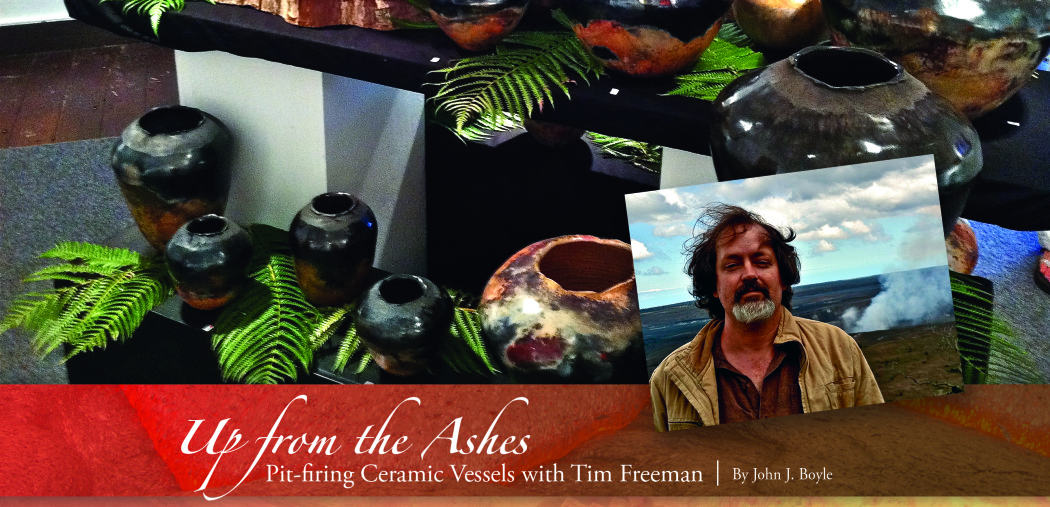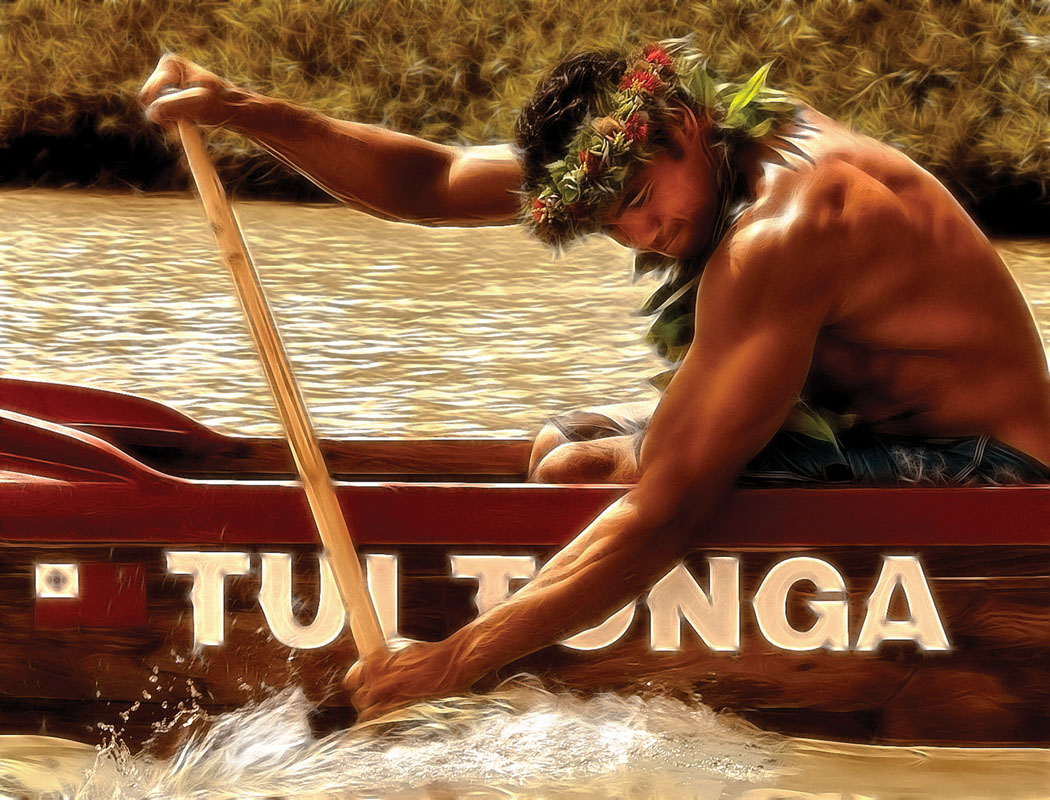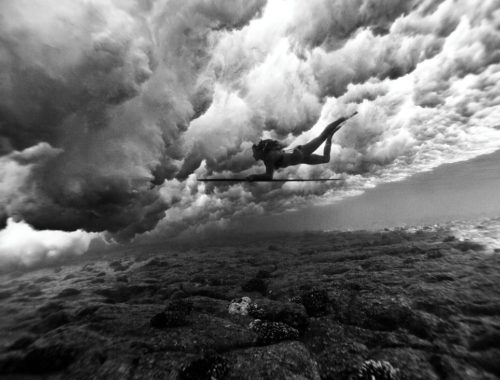
Up from the Ashes: Pit-firing Ceramic Vessels with Tim Freeman

By John J. Boyle
A close examination of a pit-fired ceramic vessel created by potter and philosopher Tim Freeman reveals details reminiscent of Hawai‘i’s active volcano. The artist, who makes his home near Kīlauea’s burning, living fire, is exploring creation from clay with fire and garnering acclaim for his efforts.
The distinctive, torn-edge rim at the top of the vessels he calls “ipu,” using the Hawaiian word for “vessel,” is suggestive of the lip of the volcano’s caldera. Peering inside, you also discover some surprising features. In the bottom, a bit of swirled clay seems molten and appears to be rising up from the depths. The interior walls are lined with a striated surface which, along with the molten swirl at the bottom, enhances the effect of looking into a crater and seeing the passage of time—just as the rising and sinking of the lava within the caldera, just as do the striations of stone in the Grand Canyon show time in ages, epochs, and eons. It is imaginable time, but only just. They are not vases for holding flowers, but wheel-thrown sculptures that capture a moment of creation in progress. The very bottom of the interior seems still bubbling with molten waves, wild and rough.
When I first met Tim Freeman, a University of Hawai‘i-Hilo professor of philosophy, he had several ceramic masks of Nietzsche on his office walls. A few years later he showed me a more recent sculpture he had done of a friend, and it had a great resemblance to the person I had met. As with his masks of Nietzsche, the mask of his friend’s face held something recognizable, familiar, known. It was more than that. He had captured an essence.
In 2009, more than ten years later, I went up to Volcano Village to meet up with Tim, and his house had grown a ceramic studio. He had built a deck to house his potter’s wheel and kiln, and his small, one-room cottage was filled with his ceramic vessels—many, many, hand-thrown and sculpted clay vessels or ipu. Since 2008, Kīlauea had become active again, and Tim’s clay sculptures had become powerfully evocative pieces that reflect his fascination with the volcano.
In his artist’s statement for a recent show at Volcano Arts Center Gallery, Tim explains:
“The interesting thing is that, when I first started making these vessels in the spring of 2009, I had not consciously remembered the last work I had done in graduate workshops in ceramics in Memphis in the early 1980s. While going through my earlier work, I found a series of vessels that I had made which clearly were a preview of this work, including even painted lava interiors. Thus, before even dreaming of living in Hawai‘i and near the summit of Kīlauea, I had been making these volcano vessels. It seems that they thus come from deep within me and that I have been somehow inextricably drawn to this place and to the making of these vessels.”
The glazed appearance of Tim’s vessels comes from a technique learned at a 2006 workshop in pit firing at The Donkey Mill in Holualoa with ceramic artist David Kuraoka. It comes from carefully burnishing the unfired clay with a polished stone until it forms a smooth, gleaming finish.
Pit firing is the most ancient way of firing ceramics. In pit-fired ceramics, no glazes are used, and the final firing is not in a kiln but simply in an open pit. The pieces are embedded in a thick layer of sawdust at the bottom of the pit and then carefully surrounded with wood, which is then set afire. The fire burns down around the pieces which are removed the next day from the ashes. No glazes can be used in a pit fire as it doesn’t get hot enough to melt a glaze, and even if it did, the ash fall would simply make a mess of any glaze. The pieces turn black where they are embedded in the sawdust while the natural color of the clay comes out where the piece is exposed to the fire. Some copper red color is added with a sprinkle of copper carbonate on the pieces after they are embedded in the sawdust and before they are buried in wood.
The unique character of his ipu vessels came as a breakthrough for Tim during that same workshop with Kuraoka, he says. “He was showing us how to do closed forms. There was one form that, as I was burnishing it, I kept thinking there was something wrong with the form. I finally realized it was upside down. So I turned it over and opened it up. I really liked the way the throwing rings spiraled all the way to the bottom. I still didn’t connect it with the volcano though, except for the color in the burnished clay. When I finally got the chance three years later at HCC [Hawai‘i Community College] to start throwing again, I knew I wanted to make these upside-down vessels, but I still wasn’t sure what they were. It didn’t take long however. When I opened the first vessel, the throwing rings didn’t spiral down quite so nicely and something made me decide to remove them. As I was cutting them away, I suddenly saw something different. I guess, perhaps, because of the 2008 eruption and the increasing activity at the summit, I had become quite captivated by the volcano and it seemed obvious then what they were.”
Tim first throws a closed form and then, after it has dried a bit, flips it and opens the ‘bottom,’ which is now the top. Imagine a bulb that is inverted and becomes a bowl. The process of inverting and then opening a closed form allows for some features that one just never sees in a conventionally thrown vessel. The splits and tears in the outside surface of the clay, which come from opening and pulling upward what was initially the base of the thrown form, evoke the fractured volcano landscape in the finished piece. The lip of the top suggests, as well, the lip of the caldera. Before initially closing the form, Tim pushes a bit of slip (very soft clay) into the hole at the top of the form. When the vessel is then inverted and opened this bit of clay seems molten and appears to be rising up from the depths. The throwing rings on the inside of the vessel are then cut away with a wire tool, leaving the striated surface which, along with the molten swirl at the bottom, enhances the volcanic effect.
After the clay has taken form and dried to a leather-hard consistency, the polishing of the external surface begins. Using a variety of smooth stones, Tim burnishes the vessel several times throughout the drying process. This time-consuming process is what ultimately gives the surface a sheen that makes the clay appear almost glasslike, as if it were glazed. The “glazing” however is merely the polished clay, and the remarkable color in the finished piece—the mirror-like black, the earthen clay color and the splotches of red from the copper—all come together in the surface to suggest, just as powerfully as the internal and external form, the volcanic landscape. The textures of rope-like pa‘hoe‘hoe lava and sharp a’a emerge from the iridescent, black-mirror surface.
The pit used for the firing itself is ten feet long, six feet wide and, at its deepest, about four feet deep. It slopes up to the level of the land, allowing ease in the loading and unloading process. Over the top is placed a metal frame that will hold a corrugated tin roof as a rain and spark shield. Above that is a plastic tarp to keep some more rain out of the fire. In each of these modifications over the years, Tim has adapted his process to his environment. Volcano Village is a scarce two miles away from the Kīlauea Crater, 4,000 feet above sea level, where an open fire in the high altitude tropical rainforest can be a challenge.
He lays the bisque-fired vessels in a bed of sawdust, each one carefully positioned to receive more or less of the heat. He then balances the rest of the wood to burn—but not collapse and crush—the delicate, ceramic pieces. Here is where the care of making art meets the random and organic process of a wild, elemental experiment. As an exercise in patience and practice, one can be sure of only relative predictability: shift happens!
The fire is lit around dusk and will burn down from a six-foot pyre to a soft, ashen jumble of coals throughout the night. Often, late into the night, when most of the wood is burned to ash, slowly by slowly, certain pieces will raise their form up out of the embers. Coals settle and shapes and figures rise. In the late morning dew he will delicately unearth each piece from the still-smoldering embers with thick leather gloves, hose off the ash and access his alchemy. In a final pass, Tim will apply a coat of wax to the work, rubbing it all over the outside to bring out a uniform and consistent, mirror-like finish that is seen in the final “Ipu.”
On his website, “Volcano Pit Fire Ceramics,” Tim writes that, “In the Hawaiian language an ipu is any kind of vessel, be it a gourd, a koa calabash, or a pot of some kind. The phrase ‘He ipu hō’ihi Pele’ thus means something like ‘A vessel showing reverence for Pele.’”
Over the years, visitors to Hawai‘i have wanted to bring home something that would remind them of their trip to the crater. Tim Freeman’s vessels are made to be taken away, and their evocation of a majestic and wonderful, natural process of transformation is an act of reverence. His is an art form that embodies the elements in nature, and how rare is an icon or reliquary that may produce a moment of stillness and contemplation. I asked Tim where his mind goes in such a meditative process and he says, “It goes where it goes…sometimes I need to think about something… sometimes I just sit and breathe as my hand does the burnishing…”
In the past few years Tim Freeman has begun to exhibit his work within the state to immediate acclaim. Last year his pieces appeared in two of the premier statewide shows, the Artists of Hawai‘i show and the Hawai‘i Craftsmen show in Honolulu. In early 2012, both the Volcano Art Center and the East Hawai‘i Cultural Center (EHCC) dedicated their first shows of the year, in conjunction with events marking the 100th anniversary of the Hawaiian Volcano Observatory, to art that was inspired by the volcano. One of Tim’s ipu vessels won first place in the juried show at the EHCC. Meanwhile the show at the Volcano Art Center was the first to feature a whole body of Tim’s work. It included about 25 of his vessels along with paintings by Catherine Robbins and Alan Fine.
As a professor of philosophy, Tim is a natural as a clay artist. In his teaching, he brings up questions to mold the mind; his ceramics suggest another kind of inquiry. It raises the question: “What is it for?” His art is ecologically low-impact, organic and ultimately biodegradable. The journey of the earth through his hands is gentle and subtly executed with grace. What he is creating defies meaning, context and use, and perhaps at best suggests reverence. His vessels are what they are, and they are beautiful.
An evening in Volcano Village often ends at the Jaggar Observatory where one can look across Kīlauea Crater to the caldera’s red circle of fire; at times there is a distant roar from the mouth of the crater, and the vessel fills and empties. It is the ebbing and flowing of lava in Halema’uma’u, “house of the soft ’ama’uma’u (or ’ama’u for short, a fern),” home of the goddess of fire and creation, Pele. A healthy fear, respect and reverence rule the senses, especially when one knows that in such a place, at any moment, one is precariously close to destruction as creation. ❖
Contact writer John J. Boyle: jjjboyle2112@gmail.com
All photos courtesy of the artist
Resources:
Tim Freeman’s ceramics are available at these galleries: Volcano Art Center, Volcano Garden Arts, Living Arts in Hawi, Stairway to Art in Hilo, Cedar Street Gallery in Honolulu
Website: tfreeman.net


